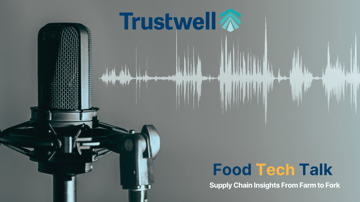In a world characterized by rapid transformations and evolving consumer preferences, the realm of food is no exception. Today, as the global population becomes increasingly interconnected and informed, the dynamics of the food industry continue to be shaped by a myriad of factors. From the preferences of health-conscious individuals seeking nourishing alternatives, to the growing emphasis on sustainability and ethical consumption, consumer food trends continue to evolve. In an era of shifting dynamics, it has become imperative for companies in the food industry to be aware of these consumer food trends to stay ahead of the curve.
As we move into the second half of 2023, we’re seeing a few consumer food trends dominate the industry – from prioritizing sustainability and self-care to rethinking meal patterns and flavors.
1. Sustainability and Transparency
Consumers' increasing concern for transparency and sustainability in the food industry stems from a growing awareness of the environmental and social implications of their food choices. They understand that their purchasing decisions can contribute to positive change and thus aim to align their values with the products they consume. In fact, according to a recent survey from Kearney, 40% of consumers factor sustainability into their food purchasing decisions. They’ve nicknamed this trend “climavorism, ” as consumers make intentional food choices based on climate impacts to lessen their carbon footprint.
An important part of the sustainability trend is also the emphasis on a transparent supply chain. Consumers want to know where their food comes from, and as such, it’s important for food companies to be able to provide that information about a product’s origin and its journey along the supply chain at any given point in time. A food traceability system can help companies track their environmental impact, providing them with information about the sourcing and sustainability of their products and ensuring that their supply chains are operating as efficiently as possible to reduce waste and conserve energy, where possible.
2. Changing Meal Patterns
The transition to working from home has undoubtedly disrupted traditional meal patterns for many individuals, prompting a shift toward more flexible and on-the-go eating habits. With the convenience of home-based work, consumers have found themselves venturing less frequently to restaurants and opting for alternatives that suit their new lifestyle. As a result, mealtime routines have become more fluid, with traditional breakfast, lunch, and dinner giving way to a preference for snacking and quick, portable meals. This change in meal patterns has led to an increased emphasis on grab-and-go options, pre-packaged convenience foods, or frozen food items.
As a result, food companies have the opportunity to be creative and innovative in the on-the-go space. However, for some food manufacturers, adding frozen items into their product line may result in additional traceability recordkeeping requirements they need to be aware of with the final ruling of the Food Safety Modernization Act (FSMA) 204. FSMA 204 states that any ingredients listed on the Food Traceability List – even if they are additions to an existing food product – must be tracked in order to ensure compliance.
3. Personal Health and Self Care
Consumers are becoming increasingly focused on their personal health. This focus is also translating into their eating and drinking habits, from decreasing their alcohol intake, to eating less sugar, to seeking out functional beverages and snacks that offer additional health benefits. There’s also been a greater interest in supplements, with consumers incorporating products into their everyday routine that can boost immunity, help manage stress, or provide extra energy.
This shift in consumer demand has spurred the industry to respond by developing and promoting a wider range of nutritious and functional foods, drinks, and supplements. Companies are adapting by reformulating products to reduce or eliminate artificial additives, preservatives, and excessive sugar, salt, and fat content, and they’re also increasing the number of organic and natural options in their product line (including plant-based and alternative-protein products). However, companies must be mindful of regulatory compliance, ensuring they’re meeting requirements for food labeling and that they’re communicating with their suppliers when product ingredients or production processes change.
4. Full Flavors and Spicy Foods
Despite rising inflation and the emphasis on healthier-for-you products, consumers are still interested in enjoying the foods that they choose to consume. Even with seeking out sustainable, healthy products, it’s important that those food products ultimately taste good, right? We’re seeing consumers being more experimentative with flavors, adding spicy ingredients and new flavors to everyday snacks and meals to “spice-up” their food experiences.
As consumers experiment with new spices and flavors, however, it’s crucial for food companies to ensure they’re authentic and transparent with the ingredients they’re marketing. With clearly defined and accurate labels, companies can communicate the origin of ingredients, the production methods, and any certifications or quality standards followed during that production. Not only is this key to keeping the consumer safe, but it’s also critical to maintaining their loyalty and trust.
Stay Ahead of Consumer Trends with Trustwell
The food industry is unique in how closely tied it is – and must be – to evolving consumer trends and preferences. To thrive in this dynamic landscape, food companies need to continuously innovate, prioritize a sustainable and transparent supply chain, and monitor the market for new and emerging consumer trends.
Companies can also consider investing in working with a trusted industry partner to aid in their efforts to keep up with and respond to consumer demands. If you’re interested in learning more about Trustwell’s solution and how we can help you stay abreast of consumer trends, connect with us today.
Other posts you might be interested in
View All Posts
Food Industry
6 min read
| August 28, 2024
Kroger’s Approach to FSMA 204 with Catherine Cosby
Read More
Food Safety
5 min read
| January 24, 2023
BUSTED: Four Myths About Food Traceability
Read More
Food Industry
4 min read
| November 7, 2019

